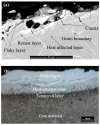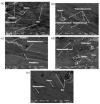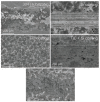Functional Surface Generation by EDM-A Review
- PMID: 36677180
- PMCID: PMC9865250
- DOI: 10.3390/mi14010115
Functional Surface Generation by EDM-A Review
Abstract
Electro-discharge machining (EDM) removes electrically conductive materials by high frequency spark discharges between the tool electrode and the workpiece in the presence of a dielectric liquid. Being an electrothermal process and with melting and evaporation being the mechanisms of material removal, EDM suffers from migration of materials between the tool and the workpiece. Although unwanted surface modification was considered a challenge in the past for many applications, this inherent nature of the EDM process has recently become of interest to the scientific community. As a result, researchers have been focusing on using the EDM process for surface modification and coating by targeted surface engineering. In order to engineer a surface or generate functional coatings using the electro-discharge process, proper knowledge of the EDM process and science of electro-discharge surface modification must be understood. This paper aims to provide an overview of the electro-discharge surface modification and coating processes, thus assisting the readers on exploring potential applications of EDM-based techniques of surface engineering and coating generation. This review starts with a brief introduction to the EDM process, the physics behind the EDM process, and the science of the surface modification process in EDM. The paper then discusses the reasons and purposes of surface modification and coating practices. The common EDM-based techniques reported in the literature for producing coatings on the surface are discussed with their process mechanisms, important parameters, and design considerations. The characterization techniques used for the analysis of modified surfaces and coating layers, as well as the tribological and surface properties of modified surfaces or coatings are discussed. Some of the important applications of EDM-based surface modification and coating processes are generating surfaces for protective coating, for aesthetic purposes, for enhancing the biocompatibility of implants, for improving corrosion resistance, for improving wear resistance, and for improving tribological performance. The current state of the research in these application areas is discussed with examples. Finally, suggestions are provided on future research directions and innovative potential new applications of the electro-discharge-based surface engineering and coating processes.
Keywords: EDM; biocompatibility; corrosion performance; electro-discharge coating; surface modification; tribological properties.
Conflict of interest statement
The authors declare no conflict of interest.
Figures





























References
-
- Ho K.H., Newmann S.T. State of the art electrical discharge machining (EDM) Int. J. Mach. Tools Manuf. 2003;43:1287–1300. doi: 10.1016/S0890-6955(03)00162-7. - DOI
-
- Ramasawmy H., Blunt L. Effect of EDM process parameters on 3D surface topography. J. Mater. Process. Technol. 2004;148:155–164. doi: 10.1016/S0924-0136(03)00652-6. - DOI
-
- Gentili E., Tabaglio L., Aggogeri F. Review on micromachining techniques. Courses Lect. Int. Cent. Mech. Sci. 2005;486:387–396.
-
- McGeough J.A., Rasmussen H. A macroscopic model of electro-discharge machining. Int. J. Mach. Tool Des. Res. 1982;22:333–339. doi: 10.1016/0020-7357(82)90010-5. - DOI
-
- Schumacher B.M. After 60 years of EDM the discharge process remains still disputed. J. Mater. Process. Technol. 2004;149:376–381. doi: 10.1016/j.jmatprotec.2003.11.060. - DOI
Publication types
LinkOut - more resources
Full Text Sources
Research Materials
Miscellaneous

